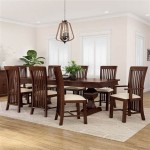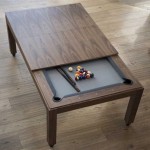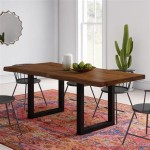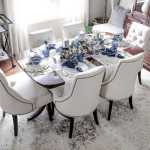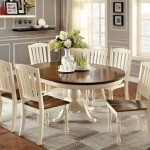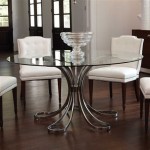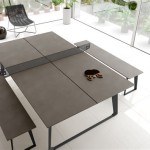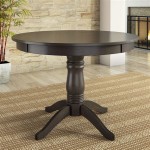The Enduring Appeal of Monkey Pod Dining Room Tables
Monkey Pod, also known as Suar wood or Acacia Koa, has gained considerable popularity in recent years within the furniture industry, particularly for crafting distinctive and aesthetically pleasing dining room tables. Its unique grain patterns, durability, and sustainable sourcing practices contribute to its desirability among homeowners and designers alike. Understanding the characteristics, benefits, and considerations associated with Monkey Pod dining room tables is crucial for making an informed purchasing decision.
The inherent beauty of Monkey Pod wood lies in its dramatic grain variations. Each slab possesses a unique combination of light and dark shades, often swirling and interweaving to create captivating visual effects. The heartwood typically exhibits a rich, warm brown hue, while the sapwood presents a lighter, creamy tone. This natural color contrast enhances the table's aesthetic appeal, ensuring that no two Monkey Pod dining tables are exactly alike. These natural variations contribute to the table's character, making it a focal point in any dining space.
Beyond its visual appeal, Monkey Pod wood boasts a notable level of durability. It falls within a medium hardness range, providing sufficient resistance to daily wear and tear without being overly brittle. This resilience allows Monkey Pod dining tables to withstand the rigors of regular use, including scratches, dents, and spills. Properly finished and maintained, a Monkey Pod table can serve as a lasting heirloom, passed down through generations.
The sustainability of Monkey Pod wood is another significant factor driving its popularity. Typically, Monkey Pod trees are harvested from sustainably managed plantations or from trees that have fallen naturally. This responsible sourcing practice minimizes the environmental impact associated with logging and helps to preserve natural resources. Many furniture manufacturers specializing in Monkey Pod tables prioritize ethical and sustainable practices, ensuring that the wood is sourced responsibly and legally.
When considering a Monkey Pod dining table, various factors come into play, including size, shape, finish, and design. The size should be proportional to the dining room and accommodate the typical number of diners. Shape options range from traditional rectangular and oval tables to more contemporary round and square designs. The finish applied to the table plays a crucial role in protecting the wood and enhancing its natural beauty. Design considerations should align with the overall aesthetic of the dining room and complement the existing furniture.
Understanding the Unique Characteristics of Monkey Pod Wood
Monkey Pod wood distinguishes itself through several key characteristics that contribute to its appeal for dining room tables. The most prominent feature is its distinctive grain pattern, often characterized by swirling, interlocking configurations of light and dark tones. These variations arise from the tree's growth patterns and the different densities of the heartwood and sapwood. This unique grain makes each table a one-of-a-kind piece.
The color variation within a single slab of Monkey Pod wood is another defining characteristic. The heartwood, sourced from the center of the tree, typically displays a deep, warm brown hue, while the sapwood, located closer to the bark, presents a lighter, creamy color. This contrast creates visual interest and depth within the table's surface. Cabinetmakers and furniture designers strategically utilize these color variations to enhance the table's aesthetic appeal. The varying shades can be arranged to create focal points or highlight specific design elements.
Monkey Pod wood exhibits a medium hardness, making it suitable for furniture that requires both durability and ease of working. While not as hard as some hardwoods like oak or maple, it provides sufficient resistance to scratches, dents, and other forms of wear and tear commonly encountered in a dining room environment. The wood's moderate density also allows for intricate carving and shaping, enabling artisans to create tables with elaborate details. This combination of workability and durability makes it a favored material among furniture crafters.
Another notable characteristic of Monkey Pod wood is its natural luster. When properly finished, the wood exhibits a subtle sheen that enhances its visual appeal. This natural luster contributes to the table's overall elegance and sophistication. Different finishing techniques can be employed to accentuate or subdue this luster, depending on the desired aesthetic effect. A high-gloss finish will amplify the sheen, while a matte finish will create a more subdued, natural look.
Factors to Consider When Choosing a Monkey Pod Dining Room Table
Selecting a Monkey Pod dining room table involves careful consideration of several factors to ensure that it aligns with individual needs and preferences. Size is a crucial consideration, as the table should comfortably accommodate the typical number of diners and fit proportionally within the dining room space. A table that is too large can overwhelm the room and impede movement, while a table that is too small may not provide adequate seating for larger gatherings. Measuring the dining room and considering the number of people who will regularly use the table are essential steps in determining the appropriate size.
The shape of the table is another important factor to consider. Rectangular tables are a classic choice that works well in most dining rooms, particularly those with a more formal aesthetic. Oval tables offer a similar level of versatility and can be particularly well-suited for smaller dining rooms. Round tables promote a sense of intimacy and facilitate conversation, making them ideal for smaller, more casual dining spaces. Square tables can be a stylish choice for modern dining rooms, providing a symmetrical and balanced aesthetic. The choice of shape should complement the overall design of the dining room and reflect the desired style.
The finish applied to the Monkey Pod dining table will significantly impact its appearance and durability. A clear finish will showcase the natural beauty of the wood, allowing the grain patterns and color variations to shine through. Stained finishes can be used to enhance or alter the wood's color, creating a specific aesthetic effect. A durable finish, such as polyurethane or lacquer, will protect the wood from scratches, spills, and other forms of damage. Consider the level of maintenance required for different finishes and choose one that aligns with individual lifestyles and preferences.
The base or legs of the table also contribute to its overall design and stability. Options range from traditional wooden legs to more contemporary metal bases. The style of the base should complement the table's top and the overall aesthetic of the dining room. The base should also be sturdy enough to support the weight of the table and ensure its stability. Consider the material, design, and construction of the base when making a selection.
Maintaining and Caring for a Monkey Pod Dining Room Table
Proper maintenance and care are essential for preserving the beauty and longevity of a Monkey Pod dining room table. Regular cleaning is crucial for removing dust, dirt, and spills that can accumulate on the table's surface. Use a soft, damp cloth to wipe down the table after each use, and avoid using harsh chemicals or abrasive cleaners that can damage the finish. For more stubborn stains, use a mild soap and water solution, followed by a thorough drying with a clean cloth. Promptly addressing spills is essential to prevent them from soaking into the wood and causing permanent stains.
Protecting the table's surface from scratches and dents is another important aspect of maintenance. Use placemats and coasters to protect the finish from heat, moisture, and scratches caused by dishes and glasses. Avoid placing sharp or heavy objects directly on the table's surface, as they can cause dents or gouges. Consider using a table pad or tablecloth for added protection, especially during formal dining occasions.
Humidity control is also important for maintaining the integrity of a Monkey Pod dining table. Excessive humidity can cause the wood to swell, while low humidity can cause it to dry out and crack. Maintaining a consistent humidity level in the dining room will help to prevent these issues. A humidifier or dehumidifier can be used to regulate humidity levels as needed. Avoid placing the table near sources of heat or direct sunlight, as these can also contribute to wood warping or cracking.
Regularly polishing the table can help to maintain its luster and protect the finish. Use a furniture polish specifically designed for wood surfaces, and follow the manufacturer's instructions carefully. Avoid using polishes that contain silicone, as they can build up over time and create a hazy appearance. Polishing the table every few months will help to keep it looking its best.
By following these maintenance and care tips, homeowners can ensure that their Monkey Pod dining room table remains a beautiful and functional centerpiece in their dining room for many years to come. The natural beauty and durability of Monkey Pod wood, combined with proper care, make it a worthwhile investment for any home.

Monkey Pod Dining Room Table Fiji Sourced Etsy Singapore

Monkeypod Tables In Honolulu Hawaii Furniture Maker Satoshi Yamauchi Custom

Monkeypod Tables In Honolulu Hawaii Furniture Maker Satoshi Yamauchi Custom
Monkeypod Tables In Honolulu Hawaii Furniture Maker Satoshi Yamauchi Custom

Monkey Pod Dining Room Table Fiji Sourced Etsy Singapore

Monkey Pod Dining Table Whole Design Warehouse Fine Furniture
Monkeypod Tables In Honolulu Hawaii Furniture Maker Satoshi Yamauchi Custom

Live Edge Dining Table Kiln Dried Custom Monkey Pod Slabs Etsy

Flat Rock Live Edge Dining Table Monkeypod Natural

Monkeypod Dining Table Furniture Maker Satoshi Yamauchi Custom In Honolulu

